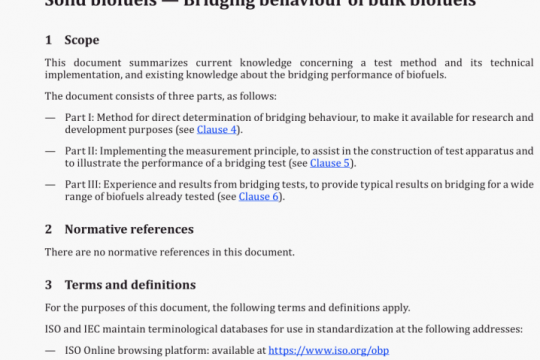ISO 8178-5 pdf free download
ISO 8178-5-2021 pdf free download.Reciprocating internal combustion engines – Exhaust emission m easurement – Part 5: Test fuels.
5.2.3 Specific considerations for marine fuels
For marine fuels (distillate and residual fuel oils), sulfur and nitrogen have a significant impact on PM and NO emissions, respectively.
Typically, the sulfur content is higher than that for onroad or nonroad diesel fuels by a factor of approximately 10, as shown in Table 22. Even without any aftertreatment system, the PM sulfur level will be approximately 0,4 gfkWh fora 2 % sulfur fuel. In addition, the high ash, vanadium and sediment fractions will significantly contribute to the total PM emission. As a consequence, the inherent engine PM emission, which is mainly soot, is only a very small fraction of the total PM emission. In the application of aftcrtreatment systems, 5.22 should be carefully considered.
The average nitrogen content of residual fuel oil is currently around 0,4 %, but steadily increasing. In some cases, nitrogen contents between 0,8 % and 1,0 % have been reported. Assuming a 55 % conversion rate at a nitrogen level of 0,8% will increase the NO emission of the engine by more than 2 g/kWh. This is a significant portion of the total NO emission and shall therefore be carefully taken into account.
5.2.4 Other fuel properties
There are other fuel parameters that have a significant influence on emissions and fuel consumption of an engine. Contrary to the sulfur influence, their magnitude is less predictable and unambiguous, but there is always a general trend that is valid for all engines. The most important of these parameters are the cetane number (CN), density, poly-aromatic content, total aromatics content and distillation characteristics. Their influence is briefly summarized below.
For NOR, total aromatics is the predominant parameter whereas the effect of poly-aromatics and density is less significant. This can be explained by an increase of the flame temperature with higher aromatics content during combustion, which results in an increased NO emission. For PM, density and polyaromatics are the most significant fuel parameters. In general, NO will be reduced by 4 % if aromatics are reduced from 30 % to 10 %. A similar reduction is possible for PM when reducing poly-aromatics from9%to 1%.
Increasing the CN will improve engine cold start and therefore white smoke emission. It has also a favourable influence on NO emission particularly at low loads, where reductions of up to 9 % can be achieved If CN is increased from 50 to 58, and fuel consumption with improvements of up to 3% for the same CN range.
5.3 influence of fuel properties on emissions from spark ignition (SI) engines
Fuel parameters that have a significant influence on emissions and fuel consumption of an SI engine include octane number, sulfur level, metal-containing additives, oxygenates, olefins and benzene.
Engines are designed and calibrated for a certain octane value or methane number. When a customer uses gasoline with an octane level lower than that required, or accordingly, a natural gas with a lower methane number, knocking can result which could lead to severe engine damage. Engines equipped with knock sensors can handle lower octane or methane number levels by retarding the spark timing.
As mentioned above, sulfur naturally occurs in crude oil. If the sulfur is not removed during the refining process, it will contaminate the fuel. Sulfur has a significant impact on engine emissions by reducing the efficiency of catalysts. Sulfur also adversely affects heated exhaust gas oxygen sensors. Consequently, high sulfur levels will significantly increase I-IC and N0 emissions. Also, lean burn technologies, which require NO aftertreatment technologies, are extremely sensitive to sulfur.
Metal-containing additives usually form ash and can therefore adversely affect the operation of catalysts and other components, such as oxygen sensors, in an irreversible way that increases emissions. For example, MMT (methylcyclopentadienyl manganese tricarbonyl) is a manganese-based compound marketed as an octane-enhancing fuel additive for gasoline. The combustion products of MMT coat internal engine components, such as spark plugs, can potentially cause misfire which leads to increased emissions, increased fuel consumption and poor engine performance. They also accumulate and partly plug the catalyst causing an increased fuel consumption in addition to reduced emission control.
Oxygenated organic compounds, such as ethanol, are often added to gasoline to increase octane, to extend gasoline supplies, or to induce a lean shift in engine stoichiometry to reduce carbon monoxide emissions. The leaner operation reduces carbon monoxide emissions, especially with carbureted engines without electronic feedback-controlled fuel systems. However increased 02 levels beyond that for which an open loop engine has been calibrated will typically increase NO emissions and combustion temperatures which can lead to premature engine failure.
Olefins are unsaturated hydrocarbons and, in many cases, are also good octane components of gasoline.
However, olefins in gasoline can lead to gum and deposit formation and increased emissions of reactive
(i.e. ozone-forming) hydrocarbons and toxic compounds.
Benzene is a naturally occurring constituent of crude oil and is also a product of catalytic reforming that produces high octane gasoline streams. It is also a known human carcinogen. The control of benzene levels in gasoline is the most direct way to limit evaporative and exhaust emissions of benzene from SI engines.
Proper volatility of gasoline is critical to the operation of SI engines with respect to both performance and emissions. Volatility is characterized by two measurements, vapour pressure and distillation.ISO 8178-5 pdf download.




